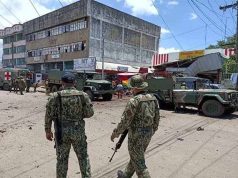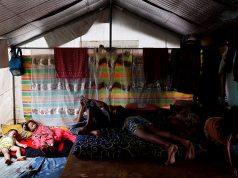The Armed Forces of the Philippines (AFP) on Monday disclosed the possibility that some 300 followers and supporters of the outlawed Maute armed group could be preparing to mount attacks at diverse parts of the country.
Remnants of Maute who figured in the Battle of Marawi City are believed to be regrouping for the purpose, according to Maj. Ronald Suscano, Spokesman of the Philippine Army 1st Infantry Division.
These elements, he said, could have dispersed to various pockets of holdout cells in Mindanao and elsewhere, and it’s not farfetched that they are continuing their recruitment drive to beef up their ranks under their leader Abu Dhar and preparing for offensive action, such as terrorist bombings.
Meanwhile, in an analysis published online at RSIS Commentary, Post-Marawi Fallout: Further Radicalization, author Jasminder Singh echoed the belief that, “while the battle for Marawi may have ended, many developments suggest that the danger of violent extremism and terrorism is far from over. Post-Marawi Philippines is seeing the re-emergence of IS-affiliated groups, raising the possibility of another Marawi-type threat in the near future.”
Jasminder Singh wrote:
Since the recapture of Marawi City by government forces in October 2017, militants affiliated with the self-proclaimed Islamic State (IS) have been pushed back into a strategic retreat. On 24 January 2018, Colonel Romeo Brawner, deputy commander of the Joint Task Force Marawi, stressed that even though hundreds of militants were killed in the battle, there are still IS-affiliated supporters and sympathizers who continue to pursue the goal of establishing an IS-styled regime in Southeast Asia.
On 20 January 2018, members of the IS-affiliated Maute Group disembarked on the southwest of Lake Lanao, less than 40 kilometers from Marawi City, the capital of Lanao del Sur. They attacked troops from Joint Task Force Ranao, injuring six before escaping by boat. The attack was the first clash since the Marawi battle and may foreshadow more trouble in the Philippines.
More to Come
Videos of the Marawi attacks continue to be circulated online and the Maute brothers have been glorified as heroes by Filipino IS supporters. Up till their current strategic retreat, IS-affiliated militants continued to claim victory. In real terms, the Maute Group and their allies failed to capture Marawi and convert it into an outpost of Abu Bakr al-Baghdadi’s so-called caliphate.
However, they managed to turn the narrative into a rallying call and a model for regional militants to emulate. For instance, they now know how infiltrating cities and setting up defenses in advance will give them the tactical advantage. Having held the military off for months, the Maute Group captured the attention of global IS-affiliated militants who were then directed to migrate to the Philippines.
Two days later, on 22 January, a Spanish national Abdelhakim Labidi Adib was arrested in Basilan, adding to the foreign terrorist numbers in southern Philippines. In the drawn-out battle, the Maute Group also systematically looted millions of dollars from homes, banks and shops, which they used for recruitment and replenishment of their capabilities.
According to estimates by the military, they could be expected to conduct renewed attacks. This is probably the reason why a former Abu Sayyaf Group (ASG) member considers the Marawi battle an ostensible success for IS-affiliated militants in the Philippines.
The Marawi Counter-Narrative
The so-called success claims of the militants need not ring true, however. Having witnessed the destruction of one of many important cities in the island group of Mindanao, local government officials and residents are supportive of military operations to wipe out the remaining IS-affiliated militants.
The manner in which the Maute Group and its allies conducted their failed attempt to capture Marawi clearly showed that they were never interested in the needs of a people who have been yearning for proper governance and economic development for decades. The aftermath of giving such groups the space to operate is unbearable – social disintegration among groups who have lived together peaceably, destruction of critical infrastructure, loss of property and business, hunger, disease and death.
With peaceful Mindanao residents supporting intensified military offensives against the militants, the Armed Forces of the Philippines’ Western Mindanao Command (Westmincom) claim that they are making great strides in diminishing the capabilities of IS-affiliated ASG in Sulu, Basilan and Tawi-Tawi provinces.
Since the operations began last year, 128 ASG members were killed, 80 were arrested and 150 others have surrendered. Notably, Westmincom has managed to achieve strategic control of the Sulu and Tawi-Tawi waters within the Tri-Border Area (TBA) of the Philippines, Malaysia and Indonesia, preventing high-profile kidnappings-for-ransom that have plagued the TBA since 2000 and was the source of funding for ASG.
The regional government of the Autonomous Region in Muslim Mindanao (ARMM) has also been working with local Islamic scholars to rehabilitate militants who have surrendered, and funded infrastructure and economic development to encourage them to give up their firearms. Together with military pressure, these programs are expected to be the beginning of the end of the ASG.Such programs – as well as the Bangsamoro Basic Law (BBL) that is expected to be passed this year – are, however, also propaganda fodder for radicalization. These peace initiatives have been framed as anti-Islam and Muslims who are supportive of peace are labeled as traitors and could be targeted by terrorists to garner support through fear. There is also the possibility of peace programs falling apart and leading to violence if they are seen to benefit certain ethnic groups or families more than others.
Far from Over
If Westmincom’s strategy in Mindanao is not followed through, there is still the possibility that another Marawi-esque battle may happen. Intelligence reports have maintained that leaders of the IS-affiliated militants – Amin Baco, Muawiyah, and Abu Turaifie – are still alive, despite earlier suggestions that Amin Baco could be dead. With millions of dollars in loot still unrecovered and being used for recruitment, the IS-affiliated militants are reorganizing their next move. New IS-affiliated cells reportedly continue to emerge in Jolo, Cotabato and Basilan.
In addition, it was recently revealed on social media that there is a female unit comprising local women and those from other parts of the Philippines who have been radicalized online. The unit is said to have been fighting alongside the male IS-affiliated counterparts, led by a female, possibly from Manila.
The militant scene in Mindanao has historically been observed to be male-dominant. If IS has been including females in the frontlines, the military should reconsider the roles that females may have been playing and factor it into their strategy.
The above revelation is part of the trend of online radicalization of Filipino Muslims in other parts of the Philippines as well as the larger diaspora. In the past few months, new social media groups have emerged, bringing together radicalized Filipino Muslims who live in Manila, Basilan and Mindanao, as well as Morocco, the Netherlands, Germany, South Korea, China and the United States.
Individuals from the diaspora who have been radicalized online should not be taken for granted. Marawi veterans who have managed to survive would likely be in contact with this vast network for recruitment and funding purposes.
Jasminder Singh is a Senior Analyst with the International Centre for Political Violence and Terrorism Research (ICPVTR), a constituent unit of the S. Rajaratnam School of International Studies (RSIS), Nanyang Technological University, Singapore. | www.rsis.edu.sg









